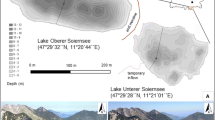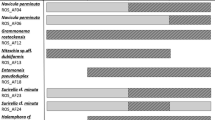Abstract.
Temporal and spatial variations were investigated in the viable diatom population of the microphytobenthic community from an intertidal sand flat of a tropical environment. The presence of diatoms to a sediment depth of 15 cm and their rejuvenation in culture revealed that their viability was not affected by the conditions prevailing at this depth. This depth harbored not only pennate (epipsammic and epipelic) diatoms, some of which are permanent residents of this area, but also centric diatoms of planktonic origin. The occurrence of diatoms such as Amphora and Navicula throughout the year in the sediments indicated that the two pennate forms were natives of this area. The centric diatom Thalassiosira, the vegetative cells of which were not observed in the sediments, must have appeared in culture through the germination of resting stages, which are regularly carried to the study area with coastal sediments and redeposited in intertidal sediments. Nutrients did not play an important role in the case of the pennates, which mainly reside in the sediments; whereas, in centric diatoms, nitrate and phosphate positively influenced their abundance. Multiple regression analysis revealed that some of the grain size fractions served as predictors of diatoms such as Amphora, Grammatophora, Pleurosigma and Thalasssiothrix. Wind stimulated the resuspension of the sediment, along with pennate diatoms, down to 5 cm depth. Correlation of chlorophyll a with diatom cell numbers, which has been generally used as an indicator of diatom abundance, revealed that chlorophyll a concentrations were good predictors of both pennate and centric diatom abundance, to 10 cm depth. However, a negative correlation between chlorophyll a and diatoms at the 10–15 cm depth, even when viable diatoms were found in appreciable numbers, suggests survival of these diatoms below the physical disturbance level through the adoption of survival strategies such as resting stage formation.
Similar content being viewed by others
Author information
Authors and Affiliations
Additional information
Electronic Publication
Rights and permissions
About this article
Cite this article
Mitbavkar, .S., Anil, .A. Diatoms of the microphytobenthic community: population structure in a tropical intertidal sand flat. Marine Biology 140, 41–57 (2002). https://doi.org/10.1007/s002270100686
Received:
Accepted:
Issue Date:
DOI: https://doi.org/10.1007/s002270100686




